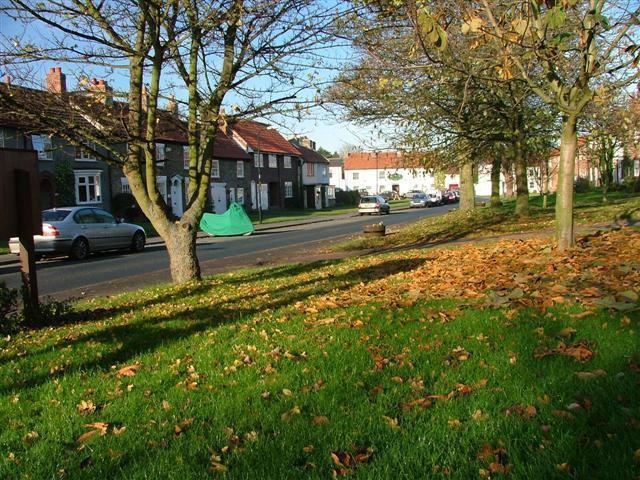Population 487 (2011) Post town NORTHALLERTON Dialling code 01609 | OS grid reference NZ390047 Sovereign state United Kingdom Local time Monday 6:27 PM District Hambleton UK parliament constituency Richmond | |
 | ||
Weather 4°C, Wind NW at 11 km/h, 86% Humidity | ||
Appleton Wiske is a small village and civil parish that sits between Northallerton and Yarm in the Vale of York, a flat tract of land that runs between the North Yorkshire Moors to the east, the Yorkshire Dales to the west and the River Tees to the north.
Contents
- Map of Appleton Wiske Northallerton UK
- Surrounding area
- Appleton Wiske in history
- Local economy
- Amenities
- Plaudits
- Panto
- References
Map of Appleton Wiske, Northallerton, UK
The village, which was known as Apletona in the Domesday Book, eventually took the name of the nearby River Wiske to distinguish itself from other Appletons in the area, such as Appleton-le-Moors. The river does not actually run through the village itself, passing about half a mile to the south on its meandering journey to the larger River Swale.
Surrounding area
There are four roads out of Appleton Wiske, each leading to a neighbouring village or hamlet. The road north leads to the tiny community of Picton whilst the road to the east - after crossing the railway line connecting Teesside to the East Coast Main Line - leads to West Rounton. Heading out of the village to the west the road runs up a small hill known locally as Cheesecake, which briefly follows the course of a minor Roman road, before passing through Hornby and into Great Smeaton. The southerly road forks, passing through Welbury on the eastern branch and through Deighton and on to Northallerton on the western one.
Appleton Wiske in history
Appleton Wiske - today just a tiny parish within the Hambleton District of North Yorkshire - is actually one of the 41 ancient parishes of the Wapentake of Langbaurgh in the Cleveland division of the North Riding of Yorkshire. It was also a part of the sessional division of Yarm.
The parish was gifted by William the Conqueror to Robert de Brus of Skelton, an ancestor of Robert the Bruce, the famous Scottish king. De Brus’s son gave it to St. Mary’s Abbey, York, along with Hornby and other lands. It remained in the possession of the St. Mary’s until the dissolution of monasteries, when it was granted by Henry VIII to Charles Brandon, who later became the Duke of Suffolk. The parish then passed though several hands and was finally split up in the early 19th century after the death of Robert Henry Allan, whose family had owned the parish since the early 18th century.
The village is thought to date back to Saxon times and, as already mentioned, is referred to in the Domesday Book as Apletona. The village church is not quite as old - the first reference to it is in 1299, when Edward I visited and heard Mass. Parish records indicate that it was being called The Chapel of St Mary Magdalen in Appleton by 1586. It is a small Norman structure, consisting of nave, chancel and porch.
In 2009 it was suggested that a planning application for nine wind turbines was due to be raised with Hambleton District Council. With each turbine planned to be 425 feet high and the nearest some 800 yards from the village some locals started an opposition group (North Hambleton Windfarm Action Group) to oppose the development. The election of a Conservative Government at the May 2015 general election made it unlikely that the development would proceed.
Local economy
The traditional source of revenue in Appleton is from farming, though weaving enjoyed a brief ascendancy during the industrial revolution. Records show that 200 looms were in operation in 1850, but the industry had almost completely disappeared by 1900. The modern population of the village still includes a fair share of farmers and farm workers, but nowadays most people commute to jobs in nearby towns, such as Northallerton, Darlington and Middlesbrough.
Amenities
Today the village boasts, in addition to the church, a chapel, a primary school, a village hall, a post office/general store and two pubs: The Lord Nelson and the Shorthorn Inn. The Lord Nelson sits at the centre northern edge of the village, fronted by a small green, and is divided into a public bar and lounge, in traditional fashion. The Shorthorn lies on the edge of the village.
A major fund raising effort in the mid-1980s saw the village acquire and develop its own recreation field. The field comprises a football pitch, a cricket square (defunct since the 2001 foot and mouth disease outbreak when playing restrictions were introduced) and pavilion, two tennis courts, a children's playground, and a skatepark. There are also recycling facilities.
Plaudits
The village won a Gold medal in Yorkshire in Bloom in 2006, 2007 and 2008, also winning best village in 2008. Appleton Wiske has also represented Yorkshire and Humberside three times in the national Britain in Bloom competition. In 2002 winning a Silver Medal, in 2004 a Silver-Gilt and Best Village and in 2009 a Gold Medal.
Panto
Every year in January the village puts on a Pantomime and the whole village gets involved in someway. The January 2016 production will be the company's 30th and will be "The Pied Piper of Appleton"
